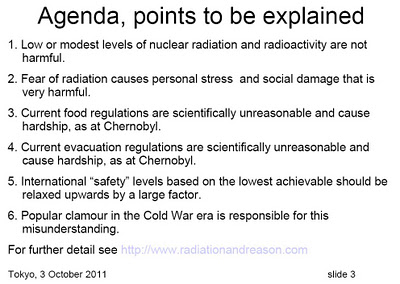Wade Allison tries to push #nuclear power on #Ireland #Fukushima #Chernobyl #ScienceMediaCentre

That world leaders are recognising climate change and have responded with a move towards renewable energy sources should be viewed as positive.
A reduction in carbon emissions, to meet the Paris agreement’s goals, by relying on the nuclear industry, is an abysmal trade-off, considering its disastrous environmental record.
Radioactive waste is a byproduct of the nuclear industry. As you correctly indicate, (Wade Allison, Irish Examiner, June 25) nuclear processes are part of nature, but these natural processes resist being hurried.
Waste takes years to decay. Plutonium has a half-life of about 24,000 years. Where does this not-so-natural waste go?
Low-level waste from hospitals is incinerated before land burial. Waste from reactor decommissioning is deposited in geological repositories.
Waste from nuclear reactors is highly radioactive, often hot, and must be stored in a controlled environment.
At the Sellafield site in the UK, where the stockpiling of nuclear waste has been plagued with leaks, spent nuclear fuel is imported and reprocessed (recycled).
Waste arising from this is highly radioactive, must be encased in glass, and be regularly monitored.
Even with best practice management, monitoring this waste will continue for indefinite years and costs will rise as the stockpiles grow.
A common practice in the nuclear industry is the dumping of low-level nuclear waste into the sea. It is claimed by Greenpeace that the spent-fuel reprocessing plant at La Hague, in northern France, dumps “1m litres of liquid radioactive waste per day” into the ocean. The long-term impact of such dumping remains to be seen.
While population displacement to facilitate hydroelectric schemes is unfortunate, relocation because of radioactive fallout is a tragedy.
The Chernobyl nuclear accident in 1986 scattered 400 times more radioactive material into the Earth’s atmosphere than did the atomic bomb dropped on Hiroshima in 1945. The Chernobyl exclusion zone, measuring 2,600sq km (1,004sq miles), is one of the most contaminated areas in the world.
It is larger than Co Wexford, where, in the late 1970s, the Irish government abandoned plans to develop a nuclear plant at Carnsore Point, following opposition and the Three Mile Island nuclear accident in the US, in 1979. The latter’s clean-up operation lasted 12 years and cost $1bn. By 2014, the price for decommissioning at Sellafield had reached £70bn.
However, a nuclear waste clean-up is a contradiction in terms. Contaminated material is simply moved to someone else’s backyard.
The Fukushima nuclear power plant accident in Japan, in 2011, is an ongoing disaster. In February, 2017, six years post-nuclear meltdown, it was reported that radiation levels at the plant were at “unimaginable levels”, following the discovery of new fuel leaks.
Professor Allison asserts that “Nuclear is for life”. Yes, it is. As he is so keen to embrace it, would he be happy take home a share of the industry’s waste?
Allison’s argument that we “must move beyond radiation phobia and accept more relaxed, evidence-based nuclear regulations” is a tall order, considering industry revelations, like the falsification of quality assurance data at Sellafield’s Mox Demonstration facility in 1999.
Undeniably, energy security comes at a cost. For nuclear energy, this is a very long-term mortgage, as both fuel and waste stockpiles create their own health-and-security risks.
There is no denying the contribution that radiation has made to medicine, but physicist Marie Curie, who did pioneering work on radioactivity, died from prolonged exposure to it.
Nuclear energy may look clean, but it is not. The spectre of artificial radioactivity from the nuclear industry looms large in our atmosphere.
Ireland has no room for stockpiles of nuclear waste, nor for the mishaps that have plagued the nuclear industry. Why jeopardise a lucrative tourism industry (€5bn a year) or our food-and-drinks industry (€12bn a year) by poisoning our landscape?
It’s not surprising that countries are refusing to invest in new nuclear plants, apart from those kowtowing to lobbyists with vested interests. Contrary to Wade Allison’s report, nuclear power seems unlikely to be popular tomorrow, given the legacy of waste it bestows on future generations.
Aidan J Collins MA
Brookville Park
Malahide Road
Artane
Dublin 5
Source of article; https://www.irishexaminer.com/breakingnews/views/readers-blog-nuclear-energy-is-a-disaster-waiting-to-happen-853590.html
(Note from Arclight2011 – More information from this blog on Prof Wade Allison https://nuclear-news.net/?s=Wade+Allison )
AND
The Economist: Oxford Professor Says OK to Raise Annual Dose Limit by 1000 Times for the Japanese, But the Reporter Reluctant to Inhale
Dr. Wade Allison is professor emeritus of physics (particle physics) at Oxford University. The event that the Economist’s reporter refers to in the article must be the talk given at American Chamber of Commerce in Japan (ACCJ) on October 3, where the professor, along with another researcher, presented the strong case that the radiation exposure below 100 millisieverts per year was not a problem, if one only gets rid of the unreasonable fear of radiation. He also says the current food regulation, evacuation regulation are “unreasonable” and should be relaxed significantly.
Here’s the screen capture of a page from his presentation slides he used in the ACCJ talk:

Arevamirpal wrote: “Why did the American Chamber of Commerce in Japan invite Professor Allison? What was the purpose? Does anyone know?”
That’s the good question!
I did look in this Allison’s biography.
He’s not a genetician, didn’t work on DNA, he is not a physician either, nor a statistician… His research field is neutrinos (what are these particules?, where are they coming from the sun?, how fast they are, etc.) It’s very theorical physic. Nothing to do with radiations and their effect on human health.
So, this so-called “expert” in nothing of an expert when it’s come to radiations and human health.
So why did he take an interest for this topic?
If you have a look on this page, where he presents his firsts results on neutrinos, you can see who are his sponsors (because you can’t work on neutrinos with only a computer, a microscope and a few tests tubes; it’s costs a lot of big money):
Atomic Energy of Canada Limited, Ontario Power Generation, Agra-Monenco/Canatom Limited, CVD Manufacturing Inc.
All these companies are in nuclear power.So, you take the money, and you have to be grateful. You come in Japan (interesting that it’s the chamber of commerce who organized the conference) and you say what your sponsors want you to say. (may be they did the slides).
As you are a scientist, in physics, and from Oxford on top of that, your titles will impress M. Everyman, and the lie has a chance to be swallowed.But if Mr Allison is an expert in neutrinos, he is nothing but a fraud when discussing human health and radiations.
The question is: has this man something like a conscience, or neutrinos and money did eat all was left of it?
1 Comment »
Leave a reply to Nick Cancel reply
-
Archives
- December 2025 (325)
- November 2025 (359)
- October 2025 (377)
- September 2025 (258)
- August 2025 (319)
- July 2025 (230)
- June 2025 (348)
- May 2025 (261)
- April 2025 (305)
- March 2025 (319)
- February 2025 (234)
- January 2025 (250)
-
Categories
- 1
- 1 NUCLEAR ISSUES
- business and costs
- climate change
- culture and arts
- ENERGY
- environment
- health
- history
- indigenous issues
- Legal
- marketing of nuclear
- media
- opposition to nuclear
- PERSONAL STORIES
- politics
- politics international
- Religion and ethics
- safety
- secrets,lies and civil liberties
- spinbuster
- technology
- Uranium
- wastes
- weapons and war
- Women
- 2 WORLD
- ACTION
- AFRICA
- Atrocities
- AUSTRALIA
- Christina's notes
- Christina's themes
- culture and arts
- Events
- Fuk 2022
- Fuk 2023
- Fukushima 2017
- Fukushima 2018
- fukushima 2019
- Fukushima 2020
- Fukushima 2021
- general
- global warming
- Humour (God we need it)
- Nuclear
- RARE EARTHS
- Reference
- resources – print
- Resources -audiovicual
- Weekly Newsletter
- World
- World Nuclear
- YouTube
-
RSS
Entries RSS
Comments RSS


Wade allison is a monster. So is stewart brand.